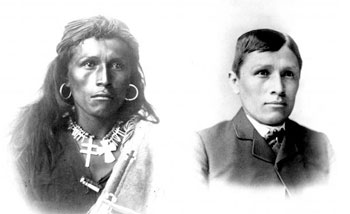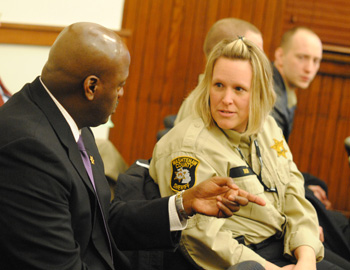Editor’s note: The new University of Michigan North Quad residential hall, which is opening this fall at the corner of State and Huron, will house the Global Scholars Program among various other initiatives. The goal of the program is reflected in a quote from a participant: “I learned to understand differences as diversity, not strangeness.” Historically, that attitude did not always serve as this country’s educational approach to other cultures – as this edition of Laura Bien’s bi-weekly history column shows.

Navajo student Tom Torlino at his arrival to Carlisle Indian School and three years later.
Eighteen-year-old George Moore boarded the eastbound train on a chill November day in 1898. Several of his schoolmates climbed on. The boys sat near Mrs. Lizzie McDonald, their guardian.
It would be a long journey.
Four days and three nights over the clacketing steel rails lay between his Idaho birthplace and a Pennsylvania boarding school.
Built in 1879, the Carlisle school was led by its founder Richard Henry Pratt, a former Civil War volunteer who after the war served as an officer in the 10th Cavalry. Its members included Buffalo Soldiers and Native American scouts. In western Indian Territory, Pratt’s group was in charge of enforcing reservation borders to protect settlers’ lands; Indians left the reservation to seek food.
Pratt was also put in charge of a group of Native American prisoners whom he treated humanely, comparatively speaking, even giving them sketch pads in which to draw their experiences. Years later in his book “Battlefield and Classroom,” Pratt wrote, “Talking with the Indians, I learned that most had received English education in home schools conducted by their tribal government. Their intelligence, civilization, and common sense was a revelation because I had concluded that as an Army officer I was there to deal with atrocious aborigines.”
However, in his later role as schoolmaster, he also said, “In Indian civilization I am a Baptist, because I believe in immersing the Indians in our civilization and when we get them under holding them there until they are thoroughly soaked.” Pratt had firm beliefs about how and why to educate his Carlisle students. In his era, Pratt’s assimilationist ideas were progressive.
George Moore, who had taken the train and attended the Carlisle School, eventually returned part-way back west – to Ypsilanti. [Full Story]







